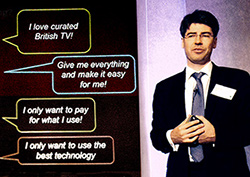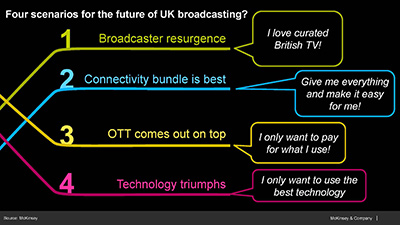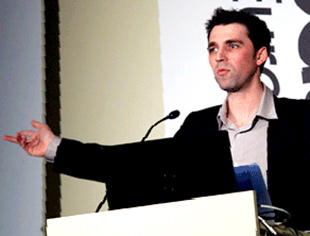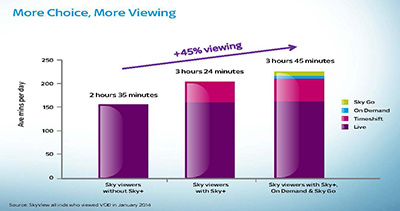![]() Nick Cohen believes that broadcast is on the cusp of being hit by the storm that has previously ravaged the print publishing and music industries.
Nick Cohen believes that broadcast is on the cusp of being hit by the storm that has previously ravaged the print publishing and music industries.
If he’s right, it’s going to be a doozy – ‘the most exciting time in the history of broadcasting’s evolution’, according to Jay Scanlan. With future and access to a connected world, the most fundamental tenets of broadcasting stand to be dramatically rewritten.
 Cohen and Scanlan’s comments are being aired at the Future of Broadcasting conference in London. Scanlan is a partner at business consultancy McKinsey & Company, while Cohen is a Managing Partner and Head of Content at MediaCom. They are pulling no punches, and there is powerful stuff to follow... the inside track from speakers from the likes of Shazam, Twitter and Google, as well as conventionally established broadcasters like the BBC, Channel 4, Sky and Discovery Networks. All have a place in the story of broadcast so far, and have plenty to say on the next chapter.
Cohen and Scanlan’s comments are being aired at the Future of Broadcasting conference in London. Scanlan is a partner at business consultancy McKinsey & Company, while Cohen is a Managing Partner and Head of Content at MediaCom. They are pulling no punches, and there is powerful stuff to follow... the inside track from speakers from the likes of Shazam, Twitter and Google, as well as conventionally established broadcasters like the BBC, Channel 4, Sky and Discovery Networks. All have a place in the story of broadcast so far, and have plenty to say on the next chapter.
Much of the talk revolves around advances in technology and opportunities – although not in the roles you might expect. And while audio is not a prime driver in the evolution of broadcasting, it has a surprising role to play. And, of course, it is an essential player.
Among the speakers, UKTV CEO Darren Childs is quick to quote psychologist Frederick Muench on the impact of choice – ‘Over the past ten years, a body of research has emerged suggesting our evolutionary drive to maximise choice combined with the abundance of choices available to us is wreaking intrapsychic havoc on our well-being’ – to drive home the impact of the upheaval that the explosion of channels, distribution models and technologies stands to deliver.

Childs is also involved in UKTV’s 2024: The Future of Television publication, a collection of essays from creative programme makers, onscreen talent, new broadcasters and professional futurists that follows up on a similar project from 2004 anticipating the shape of broadcast today. A worthwhile read. ‘Ten years ago, the industry was confidently predicting the death of TV,’ Childs says. ‘It has proven not to be the case. But the old days of nice, linear growth are over.’
He points to the iPad as a measure of change: ‘It was launched only four years ago, and that device alone has changed the way we consume TV’. But this is not simply a technical revolution – a theme that will emerge during the conference. ‘The biggest challenge facing leaders of broadcast is not technology, but the culture of their business,’ Childs warns. ‘The impact of changes in technology are dwarfed by changes in demographics and liquidity,’ agrees industry analyst Claire Enders.
Telling tales

Childs is insistent that people continue to be drawn to ‘great stories, great characters and surprises’. But their viewing behaviour is changing – while older viewers retain much of their brand loyalty, newer generations care exclusively about content, to the extent that they frequently fail to associate content with its provider.
While the means of programme delivery and consumption have yet to be properly redefined, broadcasters find themselves in a comparable corner to that occupied by the record industry, when it saw music’s traditional distribution channels all but destroyed by downloads and streaming – some of them legal, others not.
If the major record labels’ response stands as a lesson to broadcasters in how not to handle their own crisis, however, the broadcasters’ initial moves are good. Social media and second screen viewing are becoming an integral part of their strategies, supported by initiatives like Twitter’s ‘Drive to Live’.
During some of the recent FIFA World Cup qualification matches, more than 400,000 dual-screeners were sync’ed to global telecasts, and connected with supplementary content provided by app developers and app users. ‘There are many occasions when the second screen is actually the first screen,’ says Twitter Broadcast Partnership head, Dan Biddle. Where the record companies declared war on change, broadcast is making allies of new players and new technologies. Biddle refers to making Twitter ‘part of the grammar of broadcast’ and the second screen already being a ‘second microphone’ for radio.
In Google’s evaluation of change, ‘the TV zombie is dead’, replaced by ‘engagement’ of audiences. In fact, Xbox Live Europe’s Rohan Oommen reckons that the individual is now the broadcaster. ‘We think the second screen is at a fairly stable state, so we’re looking to take it to a new level,’ he says.
Certainly, the role of smart devices will be central to the reshaping of broadcasting. They have already played their part in moving viewing out of the lounge and away from real time; now they are set to become a new generation of EPG – electronic programme guide – enabling viewers to prepare an evening’s television as they travel home from work, effectively creating a personal TV channel. And, once home, the device is likely to take the place of the TV remote.
It’s what Tata Consultancy Digital Media head Helmut Scherer calls ‘content curation’.
He reports that 40 per cent of UK viewers presently spend between ten and 40 minutes surfing in three hours of viewing, and anticipates that a new role for the smart device – embracing content curation, EPG and scheduling, and television control or ‘content centric navigation’ – will keep the TV set at the centre of home viewing.
 Giving authority to this vision, BSkyB has laid claim to having introduced the world’s first ‘post-linear EPG’ in 2014. CFO/MD of Commercial Business, Andrew Griffin, says that Sky still regards the household as its main centre of service, with approximately 13 million homes yet to take up a pay TV service (representing 55 per cent penetration).
Giving authority to this vision, BSkyB has laid claim to having introduced the world’s first ‘post-linear EPG’ in 2014. CFO/MD of Commercial Business, Andrew Griffin, says that Sky still regards the household as its main centre of service, with approximately 13 million homes yet to take up a pay TV service (representing 55 per cent penetration).
Presently, around 42 per cent of UK TVs are connected via various means, and one in three TV 2013 purchases was ‘smart’. Of these, 84 per cent are internet connected.
YouView CEO Richard Halton is adamant that Freeview homes should not suffer a lack of functionality compared to premier services, a position he describes as ‘agnostic’. ‘YouView is essential in blurring the boundaries between free and paid services, giving broadcasters the chance to shape the way viewers discover content,’ he says.
The power of music
Shazam VP of Advertising Sales, Miles Lewis, brought an audio perspective to the same objective. Unequivocal about the power of music in both content and advertising, he sees it as having climbed the agenda over the past ten to 20 years. Launched in 2002 as ‘2580’, it was initially a text-based service but quickly grew in both sophistication and popularity. Finding its music recognition app in heavy use over TV adverts, Shazam is now able to build a connection between advertiser and consumer that sits outside of the broadcast channel. Calling it ‘continuing the story’, he sees advertisers linking a 30s TV slot to a four-minute online video.

‘Ad makers have a story to tell or music to sell,’ he says. With 88 per cent of UK viewers using a smart device while watching television, brands are starting to look closely at their audio infrastructure. For its part, Shazam conducted a second screen trial during the recent BRIT Awards broadcast, monitoring users’ activity against events in the show. ‘There was no promotion,’ he says, ‘it was entirely organic use.’
The result: ‘There was a lot of music sold that night.’
Shazam’s development, uptake, entry into the broadcast community and positioning to advance both the use and capabilities of broadcasting offer an intriguing insight into the industry’s evolution. In its early form as a music recognition tool and pub quiz cheat, Shazam was one of the first global Top 10 apps in Apple’s App Store. ‘It took ten years to get to the first billion uses, Lewis reports. ‘It took one year to get to the second…’
‘Access to the connected world is early and slow,’ Google’s Matt Brittin reflects. ‘Today’s pace of change feels faster than ever before but it’s slower than it will ever be.’
See also:2024: The Future of Television






